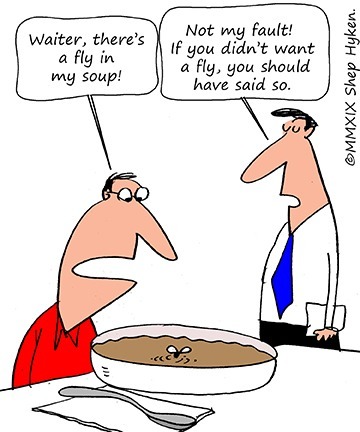Shep Hyken's Blog, page 122
August 5, 2019
5 Top Customer Service Articles for the Week of August 5, 2019
Each week I read a number of customer service and customer experience articles from various resources. Here are my top five picks from last week. I have added my comment about each article and would like to hear what you think too.
3 Small Aspects Of ‘Customer Experience’ That Make A Big Competitive Difference by Gary Lyng
(Thrive Global) How do you prevent yourself from undermining your own CX efforts so that your company can thrive? It starts with avoiding these common CX pitfalls.
My Comment: Sometimes it’s small “tweaks” that make a big difference – not big initiatives. What caught my eye when I first started reading this article was it promised three small “aspects” or ideas. I’m not sure you would call these small, but they are all relevant. And, my favorite of the three, and one I’ve been preaching for years is that CX is everyone’s job.
3 Strategies for Humanizing the Digital Customer Experience by Vibhas Ratanjee and Teresa Tschida
(Gallup) Our work with clients has shown that there are three core strategies to continue to optimize emotional connections as customers go digital.
My Comment: Another list of three ideas. This one is focused on being more human in a digital world. Love this line that in today’s digital world… “Your customers will experience less brick and more click.” The future is digital, but to get customers to emotionally connect, it still takes some human interaction.
7 Critical CRM Trends to Keep an Eye on in 2019 by Zachary Totah
(SelectHub) CRM is a competitive, growing space. Everyone talks about providing best-in-class customer experiences, about CRM strategies and solutions, and about the vital role CRM plays in catapulting companies forward as marketplace demands intensify.
My Comment: CRM (Customer Relationship Management) is an important part of the customer experience. Here are the big trends. The author interviewed me and included a few of my comments, but don’t let that stop you from reading it. Seriously, it is a good look into what customers expect and want from the companies they do business with.
10 Tips for Balancing Self-Service, Hands-On Customer Care Support by MCM Staff
(Multichannel Merchant) Panelists shared these 10 tips to help merchants determine when customer care self-service makes sense, and when to provide live agent support.
My Comment: Self-service is a powerful part of the customer experience. When done right, it creates convenience for the customer. It’s often faster and easier for the customer to get their problems resolved and their questions answered. My position is that for most businesses, not offering a self-service solution is a bad customer experience. Here are ten tips for balancing a self-service experience with human-to-human experience.
Customer Experience: The Golden Ticket to The Billion Dollar Club [INFOGRAPHIC] by Clarence Bhatti
(ProProfs) When recommending or giving reviews about a place or service, we remember the ones that provide exceptional service, positive or negative. Whether the memories associated with a place are positive or negative, we spread the word about the experience to all our friends and connections.
My Comment: This is a combination info-graphic and article. Plenty of stats, facts and quotes to help you capitalize on your customer experience. Be part of the CX “Billion Dollar Club.” Read this article and find out how.

Shep Hyken is a customer service expert, professional speaker and New York Times bestselling business author. For information on The Customer Focus customer service training programs go to www.TheCustomerFocus.com. Follow on Twitter: @Hyken
customer service training programs go to www.TheCustomerFocus.com. Follow on Twitter: @Hyken
The post 5 Top Customer Service Articles for the Week of August 5, 2019 appeared first on Shep Hyken.
August 2, 2019
Guest Blog: The Importance of First Impressions in Customer Service
This week we feature an article by Ujebardha Bekolli who writes about the importance of the first impression. Whether on the phone or in person, it’s important to train your employees the right way to interact with your customers.

The importance of first impressions
Customer service is one of the most important parts of doing business. The relationships you create with your customers reflect directly on the success of your business. One very important goal of customer service is to keep to consumer coming back.
Something that a lot of people ignore is the fact that your customers associate your company with the kind of treatment they get from the customer support employees. The people you have working in that particular department will undoubtedly set an image for your business.
 On the Telephone
On the TelephoneOne way you could be contacting your customers is by phone. These kinds of customer support groups are there to assist when people have problems using their products or services. On the phone, contact is easier to manage due to the fact that you can get away with your body language and facial expressions. Still, an immediate response is necessary so your customers don’t feel ignored and don’t get frustrated.
Face to Face
In the case when you have direct contact with the people who buy your products or services you must be extra careful. The way you look, your body language, your facial expressions, the tone of your voice and many other small elements speak for you. This is one of the reasons why companies train their employees thoroughly.
Tips on leaving a good impression
Be professional
A professional attitude and appearance is a very important element to a good first impression. That is usually distinguished by being appropriate in language and behavior, being credible and honest, and caring to help your customers. An appropriate language will get you a long way. Credibility and honesty are also signs of a professional individual. All of these show that you really care that your customers have the best experience with your product or service.
A professional attitude will also establish you as a serious company. No matter the significance of your job and the size of your business, professionalism is always a positive thing.
Know your stuff
Knowing what you are selling is the first step to a successful first experience with a customer. It is crucial that you have all the answers about the way your product works, what your service provides, or what that person will gain from buying from you. This is why companies should pay great attention to training their employees on their own products and services.
Be respectful
Finally, be respectful to your customers. This might seem like common sense, but many people ignore brands with rude employees. Having basic manners can help you keep your existing customers and gain new ones. Having a positive attitude and trying to solve problems makes a big difference. Negativity drives people away, in life and in business.
To sum up
The way your employees behave when they have direct contact with your customers is one of the most important things to work on. Teaching your employees the right manners is an investment that pays off. That’s why employee training methods are so popular.
A bad first impression is hard to fix but not impossible. A good first impression will keep people coming to you for more. This shows the importance of customer service employees and the direct role they have on the success of the organization. When a business is doing great it reflects on the size of it, the employee satisfaction, and ultimately the salaries. These are the reasons why all people inside should work towards a good reputation.
Ujebardha Bekolli is passionate about ongoing, self-motivated and self-paced learning. She writes for Kiwi LMS, which is a Learning Management Platform that aims to help restaurant owners train their staff in an easier and more effective way. Moreover, they offer online training courses for different Restaurant services.
For more articles from Shep Hyken and his guest contributors go to customerserviceblog.com.
Read Shep’s latest Forbes article: Minimalist Simplicity: A New Recipe For Convenience
The post Guest Blog: The Importance of First Impressions in Customer Service appeared first on Shep Hyken.
July 31, 2019
The Customer-Free Zone
 There’s often a disconnect between organization leaders and customers. Leaders live in a customer-free zone where they don’t interact with customers on a daily basis and therefore don’t know what customers most desire. I had the great opportunity to interview John Brandt, the author of the new book, Nincompoopery: Why Your Customers Hate You—and How to Fix It. I love the title of that book and its content, including his concept of the customer-free zone. Here’s my take on this interesting concept—or, should I say, problem.
There’s often a disconnect between organization leaders and customers. Leaders live in a customer-free zone where they don’t interact with customers on a daily basis and therefore don’t know what customers most desire. I had the great opportunity to interview John Brandt, the author of the new book, Nincompoopery: Why Your Customers Hate You—and How to Fix It. I love the title of that book and its content, including his concept of the customer-free zone. Here’s my take on this interesting concept—or, should I say, problem.
The most important factor to customers is that they feel heard and cared about by the company and its representatives. Yet sometimes these representatives are prevented from doing the best they could do for a customer. That’s because the front line is constrained with policies, procedures, and rules created by people who don’t spend enough time interacting with customers. These “rule makers” are hanging out in the customer-free zone.
It’s time to eliminate these customer-free zones. The way to do this is to put people who aren’t normally on the front line… on the front line. Usually, this is leadership, but others in non-customer-facing jobs should have similar opportunities. I’ve worked with companies that require executives to spend at least four hours a month (sometimes more) sitting next to a support center rep. Even better is when they require the executive to take an entire shift actually delivering the support instead of just watching it happen. This gives the executive a dose of reality.
Another company I worked with was very small with only a handful of employees. They wanted a customer-focused culture and required that each employee spend a shift on customer service every week. As the company grew, the leadership stepped aside to make room for more employees to experience feedback, complaints and issues their customers were experiencing. It didn’t take long for them to feel disconnected before they made the easy decision to give themselves a shift on a somewhat regular basis.
This isn’t anything new. I first wrote about this back in the 1980s—yes, that long ago—in my first book, Moments of Magic. Anheuser-Busch executives were required to spend at least one day each quarter with a field salesperson. They would ride along and interact with customers from grocery stores, restaurants, taverns—anywhere that sold beer.
Even though the idea has been around for a very long time, the term “customer-free zone” is new. Don’t get stuck far away from the realities of your business in boardrooms and executive offices. Stay out of the customer-free zone!
Shep Hyken is a customer service expert, keynote speaker, and New York Times bestselling business author. For information, contact 314-692-2200 or www.hyken.com. For information on The Customer Focus customer service training programs, go to www.thecustomerfocus.com. Follow on Twitter: @Hyken
customer service training programs, go to www.thecustomerfocus.com. Follow on Twitter: @Hyken
The post The Customer-Free Zone appeared first on Shep Hyken.
July 30, 2019
Amazing Business Radio: Josh Ginsberg

Crisis Management in the Customer Experience
How to Take Care of Your Customers When Things Go Wrong
Shep Hyken interviews Josh Ginsberg. They discuss crisis management and why brand integrity is important to customers.








The Interview with Josh Ginsberg:
When a problem or crisis occurs, it’s essential for customers to see the company take action. However, that action must come from a place of authenticity. If a company has already established a track record of integrity when there is no crisis, it will be much easier for customers to trust they will fix a problem.
There are three main components of crisis management. You must act quickly, you must be authentic, and you must communicate consistently.
66% of all consumers say that transparency is the most important quality for a brand. That means communicating even when you’re at fault or don’t have answers, being honest in your communication, and being authentic in yourself and your brand.
A crisis can have positive outcomes. If a crisis is handled well, it can increase the visibility and reputation of your brand. This, in turn, can lead to customer loyalty.
Social media has changed the landscape of brand identity and customer relationships. The many platforms allow anyone and everyone to be an influencer and to spread information quickly.
There is a fairly new expectation of companies and brands to tackle issues that may or may not be related to their product. Customers like and trust companies more that publicly take a stand on hot-button issues.
Employees have similar expectations for their company’s brand identity and integrity. When employees’ values line up with their companies’, it results in higher employee retention. It’s in companies’ best interests to consider the things their employee’s value. Employees can be a brand’s best advocates.
Quotes:
“A company’s most valuable asset is their brand.” – Josh Ginsberg
“Be authentic, transparent, and consistent in communication. When you do face a crisis, you’ll have already built that base of support and customers will trust you to make things right.” – Josh Ginsberg
“It’s important for customers to see companies take action in a crisis. But that action has to be authentic.” – Josh Ginsberg
About:
Josh Ginsberg is the founder and CEO of Zignal Labs, a media analytics platform. Previously, he served as a senior public affairs executive for Fortune 500 companies and political campaigns.
Shep Hyken is a customer service and experience expert, New York Times bestselling author, award-winning keynote speaker, and your host of Amazing Business Radio.
This episode of Amazing Business Radio with Shep Hyken answers the following questions … and more:
What do customers value in a company/brand?
How do I manage a crisis?
How do I keep my employees happy?
How can I use social media for my business?
How can I create loyal customers?
The post Amazing Business Radio: Josh Ginsberg appeared first on Shep Hyken.
July 29, 2019
5 Top Customer Service Articles for the Week of July 29, 2019
Each week I read a number of customer service and customer experience articles from various resources. Here are my top five picks from last week. I have added my comment about each article and would like to hear what you think too.
Your company has a vision: Why can’t everyone see it? by Knowledge@Wharton
(RetailWire) Presented here for discussion is a summary of a current article published with permission from Knowledge@Wharton, the online research and business analysis journal of the Wharton School of the University of Pennsylvania.
My Comment: Vision statements are important. Many companies have these, and they are general. If the statement doesn’t focus on customers, that’s fine. Then have a customer service vision statement. The key to a vision statement being successful is that is short and memorable. This article has some examples of good and bad vision statements, but they are all short. And, even better than the short article are the comments below.
Why Customer Success is Important in the Modern Age by Mia Jacobs
(Totango) This is why customer success is critical now. We are running our business in a reality of today’s customer-centered economy. Enterprises reap the most benefits of nurturing customer relationships long-term in order to keep customers constantly satisfied.
My Comment: Customer success is a hot topic. Some people still confuse what it really means. Most agree that it is about the customer having success with your product. Some companies are proactive in helping customers be successful. Some are reactive, which to me, is more customer service than success. Regardless, all organizations should consider if a customer success program is appropriate for their business. This article will help you think about what a customer success program might look like in your organization.
Make Sure You Offer Conspicuous Customer Service by Blair McHaney
(Club Industry) To ensure your members know you are thinking of them and offering them the best service they can find, you need to demonstrate conspicuously that you are thinking of them.
My Comment: This article is focused on the club industry, however the concept covered is something the author refers to as conspicuous customer service, which he defines as: “To ensure your members know you are thinking of them and offering them the best service they can find, you need to demonstrate conspicuously that you are thinking of them.” And, that applies to every business!
7 Examples Of How Digital Transformation Impacted Business Performance by Blake Morgan
(Forbes) These seven major companies show that changes might not occur overnight, but investing in digital transformation can make a large financial impact over time.
My Comment: Do you want proof that investing in delivering a digital experience is not just important, but also profitable? Then you must read this article. The author shows us the track record of seven companies that are recognized for their digital experience. Yes, it costs, but the payoff can be BIG!
Will Emotion Detection Change Customer Experience Forever? by Andrew Mort
(CustomerThink) It’s no secret that emotions drive behavior. Happy people whistle. Angry drivers crash cars. And now, with the help of emotion detection and analytics, more companies are tuning into their customers’ feelings in an attempt to learn what makes them tick.
My Comment: We measure sales, customer service, satisfaction, etc. Here’s a new one: emotion. The author defines “Emotional Detection” as measuring an individual’s verbal and non-verbal communication in order to understand their mood or attitude.” Knowing this can help understand how to sell, and more importantly, how to get a customer to come back.
Shep Hyken is a customer service expert, professional speaker and New York Times bestselling business author. For information on The Customer Focus customer service training programs go to www.TheCustomerFocus.com. Follow on Twitter: @Hyken
customer service training programs go to www.TheCustomerFocus.com. Follow on Twitter: @Hyken
The post 5 Top Customer Service Articles for the Week of July 29, 2019 appeared first on Shep Hyken.
July 26, 2019
Guest Blog: How to Make Effective Customer Experience Strategies for a Software Development Company?
This week we feature an article by Charles Richard who shares an article about how important it is for software development companies to have a successful customer experience strategy.
We all crave for “more”- entrepreneurs expect more from their employees whereas your coworkers as well customers may expect more from you. Basically, each one of us wants slightly more bang for their buck. The following post sums up a little bit in the details of what and how when it comes to customer experience strategies. We all crave for “more”- entrepreneurs expect more from their employees whereas your coworkers as well customers may expect more from you. Basically, each one of us wants slightly more bang for their buck. The following post sums up a little bit in the details of what and how when it comes to customer experience strategies.

For businesses, there are no excuses; it’s just the bottom line, and that is to provide immense satisfaction to the customers. A successful customer strategy is said only when you find yourself surrounded by an aspiration centered mainly on what matters to customers. Whether you are an online retail giant Amazon or the Walt Disney Company, an effective customer-service is something clearly that can make you a cut above. It is assumed that within a few years down the line, customer experience will overtake price and product as the key brand differentiator. If you are a software development company, it is very crucial for you to know that your online presence is significant for your company’s profitability.
Let’s Get Acquainted With the Term Customer Experience
Mainly referring to a customer’s perception of their overall interactions, customer experience has been considered as a critical driver of customer retention and acquisition. It’s way beyond attaining requests and offering assistance or help. Now many of you have this misconception that customer experience, and customer service are the same? Probably not! Being a customer, I am sure your point of contact with a company will be usually through interacting with an employee (either by visiting a store or by speaking on the phone). Here you get a chance to deliver excellent customer service. Whereas customer experience is something where you book a vacation via phone. Your tickets happen to arrive early, and the hotel automatically upgrades your room as complimentary. That’s when customer experience comes into play.
Every single touchpoint needs to be covered right from the moment they hear about you or found via Google to how easy or difficult it was to purchase things from you. Basically, the entire journey of your customer with you sums up in these two words.
Having a deep understanding of their needs
Unveil their personas
Deliver must-haves instead of nice-to-haves
What is a Customer Experience Strategy? A sum of every interaction a customer has with a business this includes both pre and post-sales. Here as a business, you need to come up with an actionable plan in place to deliver a positive, meaningful experience within interactions. So for this, you need to take certain pointers into account such as:
Competitive insight
Consumer research
Marketplace data
Mission & vision
5 Ways to Enhance Customer Experience
Get more insight into creating competitive advantage by putting your valued customer at the first place and managing several aspects such as satisfaction, reduce churn and increase revenues at once.
Create a clear vision- First and foremost step is to have a clear customer-focused vision to communicate well with your organization. One of the easiest ways to do so is by creating a set of statements, in simple words a few guiding principles.
As soon as you have these principles in place, you will find things sorted around. Make sure every team member knows what these principles are and they should be embedded in all areas of training and development.
Know your customers- Next step after making guiding principles, know different type of customers who can deal with your representatives. To understand customer needs and wants, it becomes essential for you to connect and empathize with situations often faced by them.
One of the best ways is to create a customer persona and don’t forget to give each persona a name and personality. For instance, Cookie is a 40-year-old lady who loves to explore technology. She follows techy tutorials whereas there is a guy called Tim who loves to follow precise instructions offered by the web page.
By creating personas, your customer support team can recognize who they are and understand them better. It’s also an important step in becoming sincerely customer-centric.
Emotional connection matters- Have you ever come across a phrase “it’s not what you say; it’s how you say it”? I am pretty sure you must have. The best customer experiences are the ones achieved when a number of your team creates an emotional connection.
A few days back I happened to stumble upon an interesting example that is best suited here. The company took care of the return shipping and had a courier pick up of the product as soon as it learned that their customer’s near one has passed away. In addition to this, the very next day the company sent a bouquet with a condolence note to the customer.
This is the best way to increase trust and loyalty. We are humans we can be easily emotionally attached especially with the feel when we use a product or service. Optimizing for an emotional connection can increase overall sales growth to a great extent. Emotionally engaged customers are more likely to:
Recommend your product or service
Three-times re-purchase
Less likely to shop around or find any alternatives
Much less price-sensitive
Gain feedbacks in real-time– Feedbacks have always been a must! I mean it is very important for you to know that you are delivering a wow customer experience or not? And nobody is going to take this initiative for you; you need to ask out! Try capturing feedbacks in real-time. Post-interaction surveys and similar customer experience tools can be delivered using a variety of automated tools through email and calls.
Of course, you can even think of making specific outbound calls to gain more insightful feedback.
Measure the ROI at regular intervals– Last but certainly not the least, measuring the return of Investment. I mean how do you know that all the efforts, investments made in your teams, process and technology are working and paying off?
Measuring customer experience with the help of “Net Promoter Score” or NPS can offer you some valuable information. Moreover, it is pretty easy to implement and measure makes the NPS a favorite with company boards and executive committees.
Final Verdict
Constant nurturing and care is all that takes to create an effective customer experience. Time to create an impact on customer loyalty, higher retention, and increased revenues.
Charles Richard is a Business Analyst at Tatvasoft.co.uk. He is a progressive business leader and A passionate writer. Best at analysis that can leverage the data and information needed to generate increased business value. Besides his profession, Charles likes to share some new and trending technical aspects.
For more articles from Shep Hyken and his guest contributors go to customerserviceblog.com.
Read Shep’s latest Forbes article: The Customer Experience: Eight Ways You’re Killing The Romance
The post Guest Blog: How to Make Effective Customer Experience Strategies for a Software Development Company? appeared first on Shep Hyken.
July 24, 2019
It’s Your Fault
 The other day I was leaving a parking lot that required me to pay on the way out. It was an automated system. I put my ticket in the slot, the machine calculated what I owed, and then asked me to insert my credit card to make the payment. There were even some convenient instructions on how to insert the parking ticket and credit card into the machine. Unfortunately, it didn’t work. Even worse, it took my card and didn’t give it back. The screen read, “Error. Ticket Jammed.”
The other day I was leaving a parking lot that required me to pay on the way out. It was an automated system. I put my ticket in the slot, the machine calculated what I owed, and then asked me to insert my credit card to make the payment. There were even some convenient instructions on how to insert the parking ticket and credit card into the machine. Unfortunately, it didn’t work. Even worse, it took my card and didn’t give it back. The screen read, “Error. Ticket Jammed.”
A little frustrated, I noticed a button to push for help. Within moments a woman’s voice came over the speaker asked what the problem was. I shared what happened and she said someone would be there in just a few minutes. In the meantime, cars were starting to stack up behind me. I felt terrible—and even a little embarrassed.
The woman did show up and she quickly opened the machine and gave me back my card. She wasn’t very happy with me. She said, “It’s your fault. You put the card in the wrong way.” I told her that I followed the directions that were on the little machine. Holding her ground, she said, “Well, you did it wrong.”
In the short time I interacted with this woman, she told me the problem was my fault and I was wrong. Didn’t she ever hear that old saying, “The customer is always right!”? By the way, if you’ve followed my work, you know I don’t believe in that saying. I believe the customer is NOT always right. But I always remind everyone that the customer is still the customer. Even if they are wrong, you must let them be wrong with dignity and respect.
Apparently, that’s not what this woman believed. I even said, somewhat sarcastically, “So, you’re telling me I’m wrong?” She confirmed she was. By the way, she was right. I did put the card in the machine backward. But she didn’t need to make me feel bad about it. Perhaps she could have smiled and said, “Don’t worry about this. It happens all the time. Now you know how to do it next time.”
But no. She did the opposite. And in the process, she made me feel bad and a little embarrassed.
The point of this story is a valuable lesson. There are certain phrases you should never say to a customer when they are wrong. Some of them are:
You’re wrong.
It’s your fault.
You should (have)…
Read the fine print.
You didn’t follow the directions.
You don’t understand.
Too bad.
I could go on, but you get the idea. The customer usually knows they are wrong, but you don’t have to rub it in. Remember, always treat the customer with dignity and respect. The customer will feel good about that—and you will, too.
Shep Hyken is a customer service expert, keynote speaker, and New York Times bestselling business author. For information, contact 314-692-2200 or www.hyken.com. For information on The Customer Focus customer service training programs, go to www.thecustomerfocus.com. Follow on Twitter: @Hyken
customer service training programs, go to www.thecustomerfocus.com. Follow on Twitter: @Hyken
The post It’s Your Fault appeared first on Shep Hyken.
July 23, 2019
Amazing Business Radio: John Brandt

The Trap of “Nincompoopery” in Business and CX
Forging Real Relationships with Your Customers to Deliver Excellent Customer Service
Shep Hyken interviews John R. Brandt. They discuss his new book, Nincompoopery: Why Your Customers Hate You—and How to Fix It, and how to go from being a “nincompoop” to creating an exceptional customer experience.








The Interview with John Brandt:
There’s often a disconnect between organization leaders and customers. Leaders live in a “customer-free zone” where they don’t interact with customers on a daily basis and therefore don’t know what customers most desire. The most important factor to customers is that they feel heard and cared about by the company and its representatives.
Get to know your customers. See your organization through their eyes, and take time to shop, work, and even live alongside them. Learn about their struggles and discover their biggest pain points. Then, devise a solution that eliminates multiple headaches for the customer at once. Make their lives more convenient. Sales follow convenience.
Nincompoopery is not usually the fault of any individual; its roots often lie with the company or organization. Friction needs to be eliminated at the source and on a larger scale. This starts with training, defining values, and building culture on the inside, which creates a consistent experience for the customer on the outside.
Build real, human connections with your customers. Relationships should go deeper than the transactional. This is where AI falls short. Customers still crave that person-to-person interaction.
Another definition of a Moment of Truth is “when something happens that can dramatically change the arc of the relationship between you and the customer.” Relationships are formed in these moments, in moments of crisis—both in business and in life. These moments are when you learn who you can trust and who you cannot. Prove to your customers that they can trust you.
One of the biggest gifts you can receive is a customer complaint. This is direct feedback from the customer about something that isn’t working in your organization. Use that feedback and do something with it. Make changes and improve.
Everyone falls victim to nincompoopery, but you’re only truly a nincompoop if you make no effort to grow. Consistently analyze your own performance by looking through your customer’s eyes—always look for ways to improve. Otherwise, you’ll stay stuck in nincompoopery, and there’s no future for anyone there.
Quotes:
“Some people say the secret of life is low expectations. But I don’t think we should do that to our customers.”– John Brandt
“In business, as in our personal lives, a relationship is fundamentally forged in a moment of crisis. In a moment of crisis, you find out who you can trust and who you can’t.”– John Brandt
“You can’t improve customer experience and value unless you go live with your customers. Go be a customer with your customers.”– John Brandt
About:
John R. Brandt is the author of Nincompoopery: Why Your Customers Hate You—and How to Fix It. He is also the CEO and founder of The MPI Group.
Shep Hyken is a customer service and experience expert, New York Times bestselling author, award-winning keynote speaker, and your host of Amazing Business Radio.
This episode of Amazing Business Radio with Shep Hyken answers the following questions … and more:
What is “nincompoopery”?
Why do my customers hate me?
How can I form more meaningful customer relationships?
What do customers want?
What should I do with customer complaints?
The post Amazing Business Radio: John Brandt appeared first on Shep Hyken.
July 22, 2019
5 Top Customer Service Articles for the Week of July 22, 2019
Each week I read a number of customer service and customer experience articles from various resources. Here are my top five picks from last week. I have added my comment about each article and would like to hear what you think too.
8 Tips for Improving Social Media Customer Service by Fara Haron
(Smart Customer Service) The quickly evolving social media landscape has forced companies to work harder to maintain a positive customer experience, as 83 percent of people have higher digital customer service expectations than they did last year.
My Comment: Companies are using social media customer care/service to increase loyalty and gain market share. If you’re not already strong in the area of social customer care, this article will help you get started. If you are, this will give you some reminders to consider.
What a French Creole Cooking Term Can Teach Us About Customer Loyalty by Josh Linkner
(Josh Linkner) After finishing an incredible meal in the French Quarter of New Orleans, the best part of the experience may very well be the lagniappe (pronounced LAN-yap). While it sounds like a fancy seafood dish, a lagniappe is actually an unexpected gift.
My Comment: Innovation guru Josh Linkner writes about his experience at a French restaurant in New Orleans. He experienced “lagniappe” (pronounced LAN-yap), which is getting a little surprise – an unexpected something extra. So, what unexpected “extra” can you give your customers to show you appreciate their business?
Top 14 Ways to Create a Great Customer Experience Strategy in 2019 [Updated] by Amritpal Dhangal
(Acquire) If you really want to get ahead in the game, nail down a great customer service strategy.
My Comment: If you’ve been following these weekly posts, you know I love a good list, and that’s exactly what’s in this article. 14 ways to deliver a great customer experience – and more. There are a lot of ideas here; something for every type of business in any industry.
5 Tips For Turning Customers Into Brand Storytellers by Esther Choy
(Forbes) When you give your most devoted customers a platform, you create an authentic marketing strategy that immediately builds trust with customers and potential customers.
My Comment: Musical recording artist Bonnie Raitt wrote a song, “Let’s Give Them Something to Talk About.” Do your customers talk about you? This excellent article is all about turning your customers to talk about you – telling the world (or at least their friends and colleagues) their story about the experience they had with you. That’s marketing!
4 Customer Experience Takeaways from Mary Meeker’s Internet Trends Report by Inge De Bleecker
(CMSWire) The report contained four points, in particular, which spoke to the necessity of providing great customer experiences for today’s demanding users.
My Comment: The author of this article share four customer experience takeaways she picked up from Mary Meeker’s 2019 Internet trends report. These are trends that are taking us into the future of customer experience.
Shep Hyken is a customer service expert, professional speaker and New York Times bestselling business author. For information on The Customer Focus customer service training programs go to www.TheCustomerFocus.com. Follow on Twitter: @Hyken
customer service training programs go to www.TheCustomerFocus.com. Follow on Twitter: @Hyken
The post 5 Top Customer Service Articles for the Week of July 22, 2019 appeared first on Shep Hyken.
July 19, 2019
Guest Blog: [Infographic] How Artificial Intelligence Can Help Your Brand Deliver a Better Customer Experience
This week we feature a short article and infographic from Matteo Gasparello explaining why influential brands are using the combination of artificial intelligence and data to provide customers with the experiences they want.
44% of customers are frustrated when companies fail to deliver relevant, personalized shopping experiences. – Accenture Strategy Global Consumer Pulse Research
Brands only have one shot to get the customer experience right.
There are too many options today. Too many products that perform a similar function. Not to mention a gigantic, continually growing, amount of information, images, videos and reviews for people to be influenced by…
Consumers are consequently less patient and less forgiving.
The solution?
The most influential brands in the world are showcasing how a powerful combination of Artificial Intelligence and Data gives customers the experience they want.
At Y Media Labs, we created the infographic below to illuminate:
The high cost related to delivering poor customers experiences.
The brands that are defining customer experience today through a blend of empathy and data.
6 ways that technology can help your brand to make your clients happier.
Let’s dive right in!
Matteo Gasparello is the Head of Traffic Growth at Y Media Labs. He brings to life stories written by the talented staff of YML about customer experience, design, artificial intelligence and technology.
For more articles from Shep Hyken and his guest contributors go to customerserviceblog.com.
Read Shep’s latest Forbes article: Thomas Keller: From Dishwasher To World-Renowned Chef
The post Guest Blog: [Infographic] How Artificial Intelligence Can Help Your Brand Deliver a Better Customer Experience appeared first on Shep Hyken.



